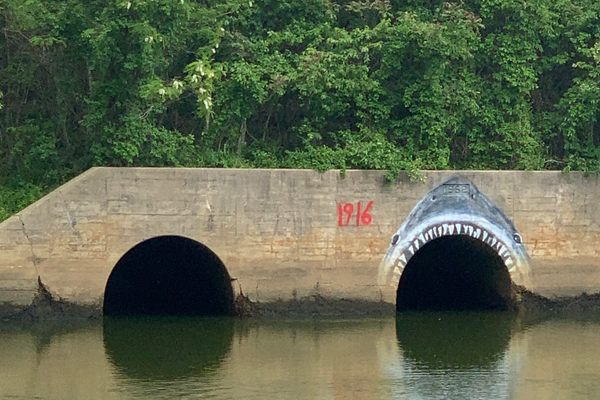The Shark Attack No One Was Expecting and Inspired ‘Jaws’
31 Days of Halloween: On Atlas Obscura this month, we’re celebrating Halloween each day with woeful, wondrous, and wickedly macabre tales all linked to a real locale that you can visit, if you dare.
Michael Schleisser and the shark caught in Raritan Bay in 1916 (via Bronx Home News)
Summers in New Jersey are often associated with trips to the Jersey Shore, and it was no different back in 1916. That July, thousands of people swarmed to the beaches seeking relief from a brutal heat wave, but what they did not realize was that this particular summer would be memorable for far more than surf and sand. It would be remembered as the summer of the Matawan Man-Eater, and would inspire the marine monster in Jaws.
On July 1, 1916, the town of Beach Haven was shaken by an apparent freak occurrence on their shores. Charles Epting Vansant from Philadelphia was visiting the shore with family when he went for a swim before dinner. Vansant was an experienced swimmer but on his way back to shore onlookers notice a large triangular fin slowly following him. Cries from the beach went unheard and suddenly Vansant’s left leg was crushed in the jaws of a massive shark. Lifeguard Alexander Ott rushed out to help Vansant out of the extremely shallow water and into medical care, but his injuries were too severe and he would bleed to death at the very hotel his family was staying in. Residents of Beach Haven believed it to be a tragic random occurrence, but they would learn in the following days how wrong they were.
Believing it was a freak accident 45 miles south of them, no one in Spring Lake, New Jersey thought twice about swimming in the ocean on July 6. Charles Bruder, a 25-year-old bellhop at the nearby Essex and Sussex Hotel, was going for a swim when he was attacked by a shark approximately 100 yards offshore.
 Philadelphia Inquirer report on the attacks (via Philadelphia Inquirer)
Philadelphia Inquirer report on the attacks (via Philadelphia Inquirer)
Onlookers saw the thrashing water and believed a man in a red canoe was in trouble, unaware that the red was not a canoe but the blood from Bruder’s injuries. Lifeguards rowed out to the bellhop, but when they pulled him into their boat they found that both his legs were gone and his abdomen was torn into. Bruder lay in the boat trying to describe what had happened before losing consciousness and dying before reaching shore. Doctors examining the body were convinced this was indeed a shark attack.
Matawan, New Jersey, located 30 miles north of Spring Lake, had undoubtedly heard about the attacks and the precautionary measures being taken by coastal New Jersey towns. Despite the panic, the residents of Matawan felt there was absolutely no reason to take any action. The town sat 15 miles inland and was connected to the ocean by the freshwater Matawan Creek, the idea of a shark attack here sounded impossible to everyone including retired sea captain Thomas Cottrell.
Bridge over the Matawan Creek where the shark was spotted (photograph by the author)
Cottrell’s opinion would change on July 12, when while walking across a trolley bridge he spotted what he knew for a fact was a large shark swimming inland up the waterway. Cottrell immediately notified Matawan authorities who dismissed his claim. Around 2 pm that day, 11-year-old Lester Stillwell was swimming in the Matawan Creek with some friends near the Wyckoff dock when he was attacked by the shark. After seeing their friend being pulled under and the water turning red, his friends sprinted into town screaming and townspeople ran to the Matawan Creek to try and find the boy. One of the rescuers was 24-year-old Stanley Fischer, who like many was unsure if it was really a shark attack, but jumped into the creek regardless in order to try and find Stillwell.
Grave of Lester Stillwell (photograph by the author)
Fischer believed he had found Stillwell’s body, when suddenly the shark sank its teeth into Fischer’s leg. While he was able to make it back to shore, the shark had torn half the flesh from his thigh, and he would die that evening at the Monmouth Memorial Hospital in Long Branch, New Jersey. Within the hour, and less than a mile from the attack on Fisher, the shark would strike again, this time attacking 12-year-old Joseph Dunn, who was also swimming in the Matawan Creek with his brother Michael and friends.
The now-quiet site of the Matawan Creek shark attack (photograph by the author)
Joseph was 10 feet from shore when the shark clamped down onto his leg and tried to drag him into deeper water, however his brother and a boy named Jacob Lefferts were able to pull him to safety. Most of the flesh had been torn off of Josephs’s leg, but miraculously the shark had failed to crush any bones or sever an artery. His faced an amputation, yet Joseph Dunn would be the only victim to survive the spree of shark attacks in New Jersey.
Matawan Creek attack site (photograph by the author)
On July 14, Michael Schleisser and John Murphy set out for a day of fishing in New Jersey’s Raritan Bay in their small motorboat. Four miles from the mouth of the Matawan Creek the boat was suddenly jerked backward and began to tip. When the men looked at their nets they saw a shark attacking their small boat. Armed only with a broken oar, Schleisser was able to kill the shark and its body was towed back to a dock in South Amboy. Most speculation if the nearly eight-foot-long and over 300 pound monster was the Matawan Man-Eater disappeared after the shark was cut open — revealing 15 pounds of human flesh and bone in its stomach.
 The Philadelphia Inquirer report on the shark capture (via Philadelphia Inquirer)
The Philadelphia Inquirer report on the shark capture (via Philadelphia Inquirer)
The string of attacks stopped with Schlesisser’s capture, ending the horror spree that racked the coast that hot July in 1916, taking four lives with it, and leaving behind a new bloody chapter in New Jersey history. The exact species of shark has never been confirmed, although it was rumored to be a great white shark — a monstrous anomaly that would inspire Peter Benchley to write his 1974 novel Jaws set on the nearby Long Island.
Philadelphia Bulletin map from July 13, 1916 of the attacks up the New Jersey coast (Public Domain)
SITE OF THE 1916 SHARK ATTACKS: MATAWAN CREEK, Matawan, New Jersey
Click here for more of our 31 Days of Halloween, where each day we’re celebrating the strange-but-true unsettling corners of the world. And check in on Facebook, Tumblr, and Twitter to participate in the daily offerings of unsavory Halloween treats.









Follow us on Twitter to get the latest on the world's hidden wonders.
Like us on Facebook to get the latest on the world's hidden wonders.
Follow us on Twitter Like us on Facebook